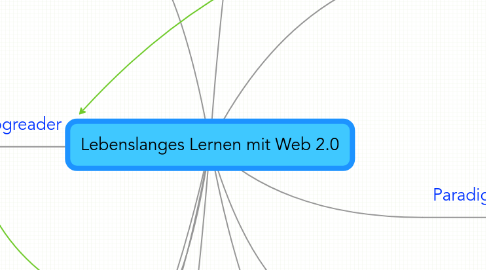
1. Weblog (Blog)
1.1. Notizbuch
1.1.1. privat
1.1.2. öffentlich
1.1.3. kommentierbar
1.1.4. üblicherweise chronologisch absteigend sortiert
1.2. Kommunikationsplattform
1.2.1. Kommentare
1.2.2. Peer-Review
1.3. z.B. NIS Kosten/Nutzen Blog
1.4. RSS-Feeds
1.5. Beispiele
1.5.1. Blogger (Google)
1.5.2. Wordpress
1.5.3. Content Management Systeme (CMS)
2. Blogreader
2.1. Subscription von RSS-Feeds
2.2. "Pull" statt "Push"
2.2.1. kein Spam
2.2.2. "Ich bestimme!"
2.3. Wie Posteingang, nur für das Web
2.4. Eigene Zeitung
2.4.1. Über RSS-Feeds zusammengestellt
2.4.2. Leicht änderbar
2.4.3. Neue Interessen, neue Inhalte
2.5. Browser
2.5.1. Flock
2.5.2. Internet Explorer
2.5.3. Firefox
2.6. Web-basiert
2.6.1. Bloglines
2.6.2. Google Reader
2.6.3. myMSN
2.6.4. Google Personalized Homepage
3. Inhalte suchen
3.1. Technorati
3.2. Google
3.3. Suchen generieren RSS-Feeds
4. Personal Learning Environment (PLE)
4.1. Content Management System (CMS)
4.2. Nicht institutionsgebunden
4.2.1. Nachhaltigkeit
4.3. Learning Management Systeme
4.4. RSS-Aggregator
4.4.1. iGoogle
4.4.2. Blogreader
5. Rechtliche Aspekte
5.1. Creative Commons
5.2. Code of Conduct
6. Ein Knoten des Netzes werden (Meine Community)
6.1. Autoren "folgen"
6.2. Kommentieren
6.3. Inhalt anbieten
6.4. "Verfolgen" lassen
7. RSS - Format
7.1. Beispiel
7.2. Integrator
7.3. Standard
7.3.1. Really Simple Syndication
7.3.2. Rich Site Summary
7.3.3. RDF Site Summary
7.3.3.1. Resource Description Framework
8. Participative Web
8.1. Jeder kann sich einbringen!
8.2. Services
8.2.1. Text
8.2.1.1. Blogs
8.2.1.2. Wikis
8.2.1.3. Google Documents
8.2.1.4. Google Notebook
8.2.1.5. Zotero
8.2.1.6. Ubernote
8.2.1.7. Evernote
8.2.2. Bilder
8.2.2.1. Flickr
8.2.2.2. WikiMedia
8.2.3. Literatur
8.2.3.1. CiteULike
8.2.3.2. Connotea
8.2.3.3. 2Collab
8.2.3.4. Zotero
8.2.3.5. BibSonomy
8.2.4. Präsentationen
8.2.4.1. Slideshare
8.2.5. Recherchen
8.2.5.1. National Library of Medicine
8.2.5.2. Google News Suche
8.2.5.3. Technorati
8.2.6. Links
8.2.6.1. Del.icio.us
8.2.6.2. Digg
8.2.6.3. Diigo
8.2.7. Orte
8.2.7.1. Google myMaps
8.2.8. Mindmaps
8.2.8.1. Mindmeister
8.2.9. Videos
8.2.9.1. Google Video
8.2.9.2. YouTube
8.2.10. Personal Spaces
8.2.10.1. mySpace
8.2.10.2. FaceBook
8.2.10.3. StudiVZ
8.2.11. Kurznachrichten
8.2.11.1. Twitter
8.2.11.2. Plurk
8.2.12. Social Networks
8.2.12.1. Ning
8.2.12.2. Facebook
9. Paradigma "Teilen"
10. Lerninhalte
10.1. Relevanz
10.2. Nützlichkeit
10.2.1. Inhalt
10.2.2. Zeit
10.2.3. Ort
10.2.4. "Ich entscheide!"
10.3. Interaktivität
10.3.1. Anwenden
10.3.2. Transponieren
10.3.3. Kommunizieren
11. Informelles Lernen
11.1. Selbstbestimmt
11.1.1. Was
11.1.2. Wann
11.1.3. Wo
11.1.4. Wie
